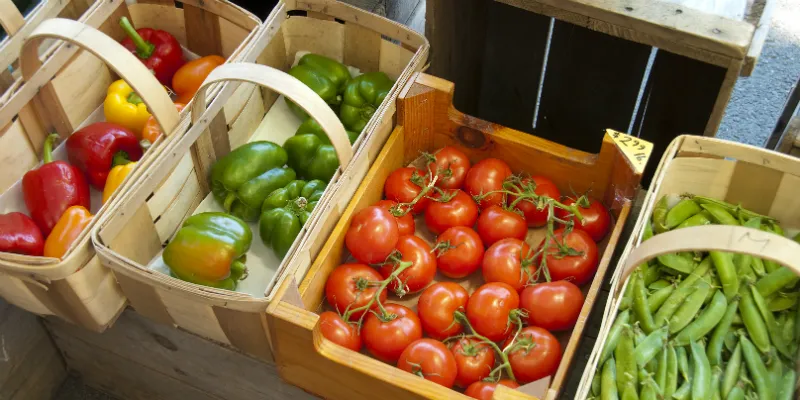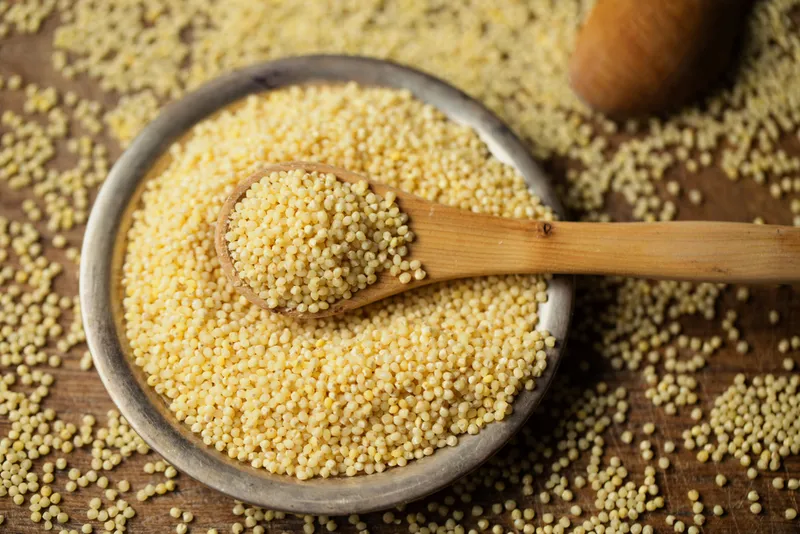Healthy grains and immersive dining: Food trends that will rule in 2024
A roundup of the most prominent trends that are likely to influence what’s on our plates in 2024.
2023 was a year of many firsts. From cottage cheese ice-cream and potato noodles to lemon popcorn, many dishes became viral this year. At the same time, India started embracing new and healthier eating habits–including reduced consumption of wheat and flour, and switching to healthier grains like millets on the back of the government’s push, declaring 2023 as the ‘Year of the Millets’.
Interestingly, food ordering app Swiggy India’s annual report for 2023 is proof—they saw a 124% growth in orders for millet-based dishes and a 38% increase in search queries for them. Furthermore, foxtail, jowar, bajra, ragi, rajgira, and amaranth were the most searched keywords on Swiggy in the healthy food category.
Similarly, the quest for clean eating made vegan and sugar-free desserts immensely popular, with 2.1 million orders for sugar-free desserts on Swiggy in 2023. Veganism became the most common dietary preference, as the orders witnessed a 38% increase in search queries for them.
However, India’s love for biryani and pizzas remained intact in 2023. A staggering 10.09 crore biryani orders were placed through Zomato; pizzas grabbed the second spot at over 7.45 crore orders.
That’s not all. Indian cuisine became more widely accepted across the world, with classic dishes being reinterpreted in an elevated format. This made it clear that our food is not just about spices and curries—there’s a world of micro cuisines that’s waiting to be explored. Fusion food gained prominence, taking regional dishes to a whole new level, albeit with a global twist.
This is just a snapshot—however, we are excited to know what’s in store in 2024. Will the above-mentioned food trends continue to stay? What will make India’s consumers tick? YS Life asks some culinary experts to break it down.
Plant-based innovation and clean eating is here to stay
From plant-based meats to the use of indigenous ingredients that scream sustainability, 2024 will be a year that will continue to see this trend flourish.
According to a report released at the second Plant-based Foods Summit by the Plant Based Foods Industry Association in Delhi in May 2023, there was a noticeable increase observed in the adoption of plant-based eating habits in the country, with factors such as increasing awareness about animal welfare and its capabilities to reduce the incidence of chronic diseases.

Favourites like Greenr and People of Tomorrow in Delhi expanded their outlets, while Mumbai saw the opening of the garden restaurant Sukoon in Bandra that serves vegan, vegetarian, and Sattvic dishes.
“Healthy eating will certainly top the charts—besides, 2024 will be a year of ingredient-based and cuisine-based trends at the same time, both falling in the progressive and classic categories at the same time. Plant-based meats and sustainable ingredients will be at the forefront, particularly with the kind of awareness today and greater inclination towards better eating habits,” says Om Nayak, chef and Co-founder at The Pasta Bowl Company, Gurugram.
Similarly, Tanmoy Ghosh, executive chef at Madam G, a Kolkata-based fine dining establishment, believes that while consumers may look at clean eating solely from a health perspective, as a chef, he also sees it as a response to environmental concerns of live farming.
“I believe more needs to be done to honour seasonal produce and support towards our industry. The point is to be creative but feed the world with less impact on our planet,” he adds.
Vocal for local
The clarion call for ‘vocal is local’ is not just limited to Made-in-India products, but also extends to the food industry, with a stronger focus today on using seasonal and local produce, including fruits and vegetables, herbs and even grains like millets.
For instance, the farm-to-table concept that has become increasingly popular post COVID-19 encourages the use of ingredients that are grown not too far from where they are eaten.

Many restaurants such as Elina Vara in Delhi and OMO in Gurugram have adopted this concept to grow their produce in the backyard or kitchen garden. Additionally, restaurants and bars with multiple outposts across locations have altered their menus to suit the palate and produce of that particular city or state. While Fig and Maple has advocated sustainable and ingredient-forward eating in its Delhi outlet; in Goa, the menu is laced with seafood options and of course, local ingredients. Its Konkan Ceviche is a big draw!
Additionally, many restaurants are taking the unconventional route to introduce multiple seasonal menus across the year, in an attempt to make the most of the local produce.
For instance, The Bombay Canteen periodically offers dishes that spotlight warm and comforting regional flavours. Its recent winter menu highlights local, indigenous produce and mimics eating styles across India during this time of year. Some of the dishes on offer include Charred Gobi Hummus, Turnip Tikki Chaat, Jodhpuri Pyaz Kulcha, Chicken Jhol Momos, Syrian Marrow Masala, and desserts like Strawberries and Cream, and Black Carrot Toffee Pudding.
Chef Maxime Montay, who heads the kitchen at Anvaya Delhi and Monique Patisserie, believes people are more aware today, which is what has led to a greater shift towards wholesome fresh food.
“We have gone farm-to-table with our menu. Our vegetables and greens are grown locally at Anvaya, and we are highly focused on the use of quality ingredients. We believe in going as local as you can,” he says.
Healthier grains rule the roost
At the G20 summit in India last year, world leaders were served a millet-based menu that comprised varieties like sorghum, pearl millet, foxtail millet, and finger millet, among others. These grains are far more nutritious than wheat and flour, packed with protein, fibre, essential vitamins, and minerals.
In an earlier chat with YS Life, former MasterChef Australia judges—Gary Mehigan, Matt Preston, and George Calombaris emphasised how they have used healthier ingredients in the dishes they served to diners in India.
“Previously, there was more use of flour in dishes here, say about two decades ago. Keeping in view the transition in tastes today, with health as the centrepiece, we have used khapli wheat and ragi in our dishes…we have used four millets,” Mehigan said.

The trend is only likely to become more prominent in 2024.
Chef Sombir, culinary partner at Bengaluru’s Jamming Goat 3.0, believes there will be an increasing preference for locally produced millets like quinoa, finger millets, and barnyard millet.
“We are increasingly using these ingredients in our menus and adapting with the food trends of the industry. In a nutshell, we are all about reinforcing cultural and familial bonds using ingredients sourced only in the country,” he adds.
Focus on immersive dining
Unlike earlier, India’s consumers are on the lookout for more immersive dining experiences that go beyond the ordinary.
In 2023, Le Petit Chef, a fun culinary ‘theatre’ steered by the world’s smallest chef—an animated Frenchman—who is all of 6 cm tall, became a rage in the national capital.

The visual spectacle, using 3D projection mapping technology created by Belgium-based Skullmapping, has the animated chef whipping up a gastronomic gala on the table for a duration of 90 minutes.
“It was an experience of a lifetime witnessing something of this scale in India. Why would I just step out to eat food when I can order anything within the comfort of my home? At the end of the day, everything from the food to the service, presentation to music matters—only then will I shell my money,” says Arunima Pandit, a 33-year-old sales manager from New Delhi.
Gaurav Sinha, Hotel Manager at JW Marriott Hotel Bengaluru, shares a similar view. “The dining experience today transcends traditional boundaries, becoming an immersive journey where technology meets gastronomy. Virtual dining experiences, interactive menus, and culinary storytelling redefine how we engage with food, making each meal not just a physical nourishment but a multisensory exploration,” he reiterates.
Combining Indian and modern cuisine
In the last few years, Indian cuisine has taken the world by storm in its elevated avatar. Moving away from curries and kormas, new-age Indian chefs have been consistently experimenting with and tapping into the power of indigenous ingredients, and at the same time, combining it with global techniques for extra flair.
In an earlier interview with YS Life, the head chef at Mumbai’s Masque, Varun Totlani had revealed how some of the best meals in his life were at the most unassuming places. This also extends to Masque’s menu which focuses on a regional-inspired approach.
While every dish has been carefully thought out, Totlani has a soft spot for a dessert of cacao, gondhoraj and chocolate, which is a tribute to the Indian bean-to-bar revolution.
“It uses the cacao fruit and is served within the dried pod shell, utilising as much of the ingredient as we could. Another is the seaweed and ponkh bhel–a spin on a Bombay favourite that uses Goan seaweed and seasonal ponkh in a totally unexpected way,” adds Totlani.
This trend will see further growth in 2024, says Kushal Raj S, co-owner of Bengaluru pub, Sector 144. “Combining Indian and modern cuisine can create delicious fusions, as people are interested in trying innovative dishes. Interestingly, it is these dishes that have become the signature offerings of those restaurants,” he concludes.
India loves its food, and there’s always room for innovation and experimentation. Tell us what’s one trend that you expect to make waves in the food industry in 2024?
Edited by Megha Reddy







